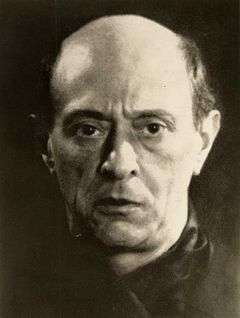Pelleas und Melisande (Schoenberg)
Pelleas und Melisande, Op. 5, is a symphonic poem written by Arnold Schoenberg and completed in February 1903. It was premiered on 25 January 1905 at the Musikverein in Vienna under the composer's direction in a concert that also included the first performance of Alexander von Zemlinsky's Die Seejungfrau.[1] The work is based on Maurice Maeterlinck's play Pelléas and Mélisande, a subject suggested by Richard Strauss. When he began composing the work in 1902, Schoenberg was unaware that Claude Debussy's opera, also based on Maeterlinck's play, was about to premiere in Paris.

Instrumentation
The symphonic poem is scored for piccolo, 3 flutes (3rd doubling 2nd piccolo), 3 oboes (3rd doubling 2nd English horn), English horn, E flat clarinet, 3 clarinets in B flat and A (3rd doubling 2nd bass clarinet), bass clarinet, 3 bassoons, contrabassoon, 8 horns in F, 4 trumpets in E and F, alto trombone, 4 tenor trombones, tuba, timpani (2 players), triangle, cymbals, tam-tam, large tenor drum, bass drum, glockenspiel, 2 harps, and strings.
Structure
The work is in the key of D minor, and is an example of Schoenberg's early tonal works. It is one continuous movement which comprises many inter-related sections. The major sections are delineated by the following tempo markings:
- Die Achtel ein wenig bewegt — zögernd
- Heftig
- Lebhaft
- Sehr rasch
- Ein wenig bewegt
- Langsam
- Ein wenig bewegter
- Sehr langsam
- Etwas bewegt
- In gehender Bewegung
- Breit
Alban Berg provided a formal outline demonstrating a combination four movement symphonic form and a single movement sonata form with connections to scenes from the Maeterlinck play.[2][3]
| Sonata form | Introduction (0), First theme group (5), Transition (6) Second theme group (9), short recapitulation (14) | The forest, Marriage of Golaud and Melisande, Pelleas, Awakening of love in Melisande |
| Scherzo and episodes | Scherzo (16), episode 1 (25), episode 2 (30) | Scene at the fountain, Scene at the tower, Scene in the vaults |
| Slow movement | Introduction (33), Love Scene (36), Coda (48) | Fountain in the park, Love Scene, Death of Pelleas |
| Finale/recapitulation | Recapitulation of introduction to first movement (50), principal theme (55), love theme (56), epilogue with further recapitulation(62) | Melisande's death |
Theme groups, similar to the leitmotif, which are associated with individual scenes or people, form the building-blocks of a symphonic development, which has its beginning in the forest scene introducing the first movement, where Golaud meets Melisande and they marry, and continues on through the inner segments of the Scherzo, which portrays the scene at the fountain where Melisande loses her wedding ring and encounters with Golaud's half-brother Pelleas, and Adagio, which portrays the farewell and love scene of Pelleas and Melisande, where Golaud kills Pelleas, and leads to the recapitulation of the thematic material in the Finale, which portrays the death of Melisande. In a letter to his brother-in-law, Alexander Zemlinsky, who wanted to make cuts in "Pelleas" for a Prague performance he was to conduct in 1918, Schoenberg summarized the fundamental anchoring points of this work: "the opening motif (12/8) is linked to Melisande", which is followed by the "fate motif", and the Scherzo contains "the game with the ring", the Adagio the "scene with Melisande's Hair", and the "love scene; […] the dying Melisande" and "entrance of the ladies in waiting, Melisande's death" in the finale.
Melisande's themes are based on a three-note motive
common to several themes in the work.
The first Melisande theme is followed immediately by the "fate" theme.
After a forceful statement of the fate theme Pelleas' motif (which contains the three note motive from Melisande's theme) is introduced.
Influenced by Pillar of Fire, a ballet version of his Verklärte Nacht by Antony Tudor, which premiered in 1942 in New York, Schoenberg, in American exile, decided for commercial reasons to modify and arrange the work's score for ballet as well, by expanding the one-movement symphonic poem into a multi-movement suite. Schoenberg first spoke of this in early 1947, in a letter to his son-in-law Felix Greissle. However, the project collapsed due to the intervention of Associated Music Publishers, who managed to prevent authorization.[4]
Selected discography
- Pelléas et Mélisande. Gabriel Fauré, Arnold Schoenberg. Hans Vonk, Saint Louis Symphony Orchestra. PENTATONE PTC 5186324 (2008).
- Pelleas und Melisande (coupled with Variationen für Orchester op.31). Chicago Symphony Orchestra / Pierre Boulez. Erato 2292-45827-2 (1992)
References
- Malcolm MacDonald, Schoenberg (Oxford and New York: Oxford University Press, 2008): p. 50.
- Walter Frisch, The Early Works of Arnold Schoenberg, 1893–1908 (Berkeley and Los Angeles: University of California Press, 1993): p. 160.
- Derrick Puffett, "'Music that Echoes within One' for a Lifetime: Berg's Reception of Schoenberg's Pelleas und Melisande", Music and Letters 76/2 (1995): .
- Therese Muxeneder, "Introduction to Pelleas und Melisande". Arnold Schönberg Center. Retrieved 2016-05-17.
Further reading
- Schoenberg, Arnold. Five Orchestral Pieces and Pelleas und Melisande in Full Score. New York: Dover Publications reprint of two CF Peters originals (1912), 1994. ISBN 0-486-28120-5.
External links
- Pelleas und Melisande: Scores at the International Music Score Library Project (IMSLP)